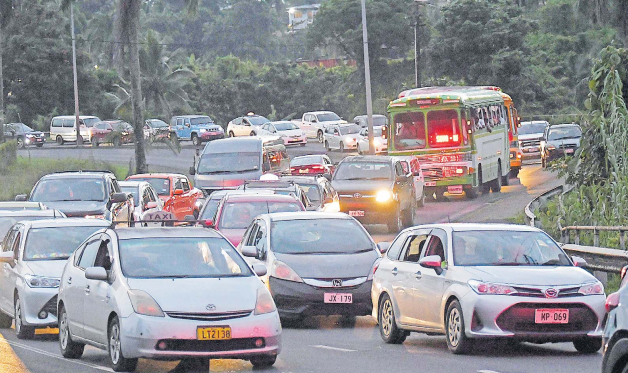Bus transportation
THE peer review found 46 per cent of the total transport in Suva is by bus. Public buses account for a significant portion of the transportation in Suva, indicating that buses are an important and widely used mode of transport. The report adds this could be a sign of a relatively robust and affordable public transport system that serves a large portion of the population, which supports economic development by providing affordable and accessible transportation options.
Taxi fleet
There are 7000 registered taxis in Suva, states the report. The large number of taxis suggests that private transportation is also a significant part of Suva’s transport infrastructure. Taxis provide an essential service, especially for individuals who need flexible, door-to-door transport options, states the report. This could point to an economic reliance on small-scale, informal transportation services.
Parking spaces
The report states in Suva City there are 628 parking spaces that are controlled by parking meters. Suva has a formalised on-street parking system in place, which can help manage urban traffic and create orderly access to parking spaces in busy areas.
“However, this also suggests potential congestion issues, as limited parking spaces could lead to over-demand for public and private vehicles.
Occupancy of metered parking spaces
The report states 80 per cent of on-street parking spaces are occupied. High occupancy rates (80 per cent) indicate that Suva’s central urban areas face significant parking pressures, which is typical for cities with growing populations and high traffic volumes. This could reflect both a demand for vehicle access in the city and potential challenges related to urban congestion, said the report. High occupancy rates suggest that there might be a need for improved urban planning, including the creation of additional parking spaces, or the promotion of alternative transport modes like public buses or cycling.
Sustainable transport systems
The peer report states there is no comprehensive and updated data on access to safe transport for Suva City. It adds the most recent Greater Suva Transportation Strategy (2015-2030) (Fiji Road Authority, 2014) highlighted the reliance on public service vehicles (bus, taxi and minibus) as they accounted for 57 per cent of all trips in the great Suva area, although it must be considered that the last available data is from 2001.
However, the number of cars on Suva’s roads has increased significantly over the past two decades, leading to severe traffic congestion, especially during peak hours. Despite infrastructure improvements, the situation remains challenging due to the continuous addition of vehicles.
“The Greater Suva Transportation Strategy 2015-2030 (Fiji Road Authority, 2014) lists several improvements that are needed to improve the public transport situation in the city. These include the need to:
• introduce dedicated bus lanes;
• improvement of the bus terminals (specifically the Suva and Nausori bus terminals);
• the linking of traffic signals using a vehicle actuated system that should improve the management of the available road capacity; and
• intersection upgrades with 31 intersections having been identified needing improvement over the short term, predominantly on road safety grounds,” states the report.
The strategy refers to an analysis of crash data from the Fiji Police Force traffic division that revealed that pedestrians are over-represented among crashes.
“For this reason, it suggests that pedestrians be better protected through new pedestrian crossings, improved lighting and adequate footpaths. The need for proper footpaths could not be over-emphasized. As SCC aims for Suva to be a healthy city, it promotes physical exercise, and walking is an important element of this (many people do walk out of necessity in Suva),” states the report.
Proper footpaths are a necessity. Currently people risk twisting their ankles or having even worse injuries when walking on roads without footpaths or footpaths which are broken or uneven. The report adds this is an important element for making the city accessible to people living with disabilities. Wheelchair bound people and those who are visually impaired need proper footpaths to have better access to the city and services. In addition to this, proper bicycle lanes would also be imperative for a city that promotes healthy living and less dependence on cars for transport.
Smart mobility and
transportation
The report recommends Suva City must have intelligent mobility and transit to promote sustainability and lower carbon emissions. It adds SCC should incorporate technology to increase mobility, decrease congestion, and improve transportation efficiency. Intelligent traffic management systems, which utilise data and predictive analytics to improve traffic flow, smart parking systems, which use sensors and data to assist drivers in discovering available parking spots. Traffic and transport specialisation engineers can be consulted to provide a traffic design and management plan. The last one, which was part of the Suva Town Planning Scheme was made in 1979.



